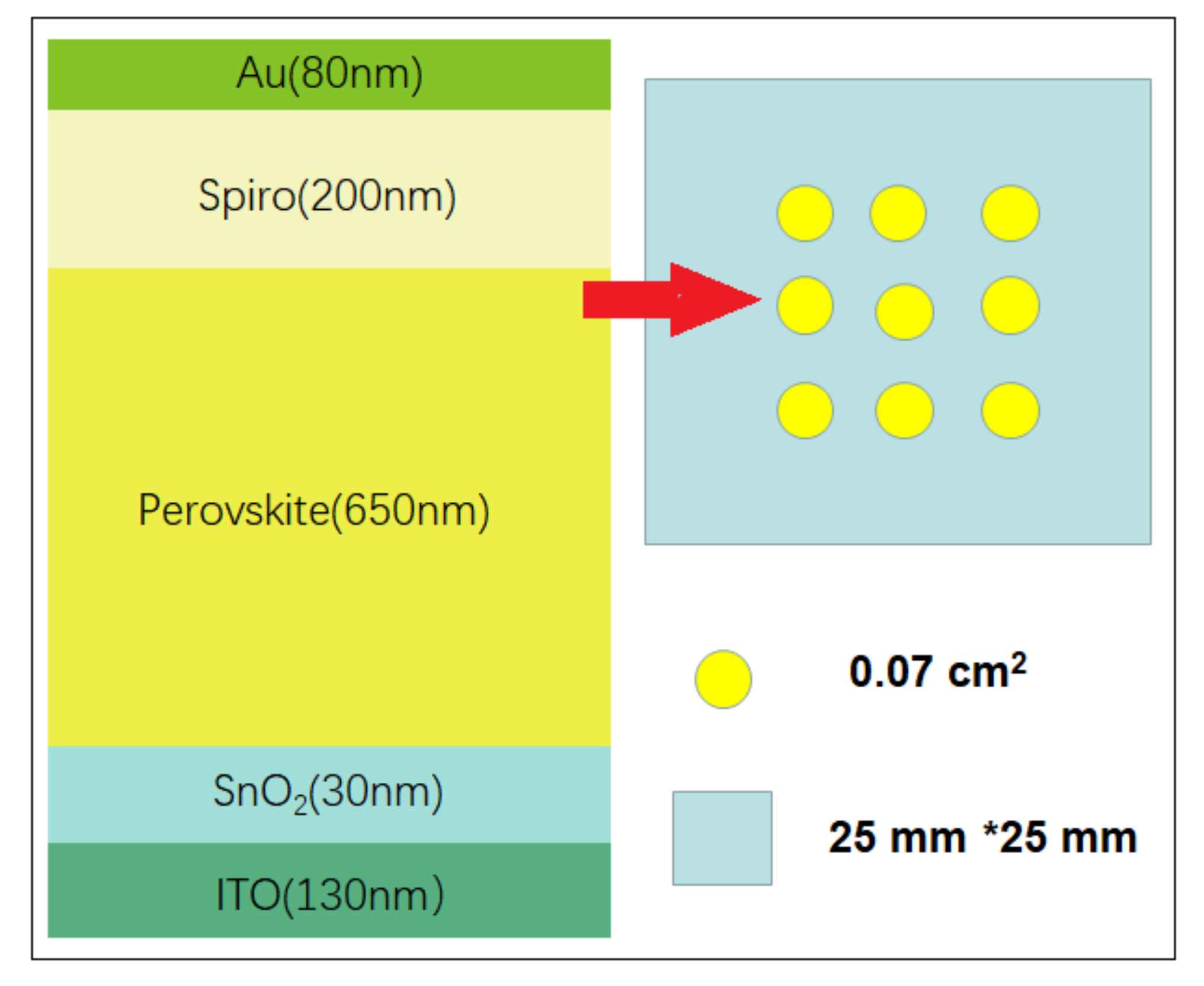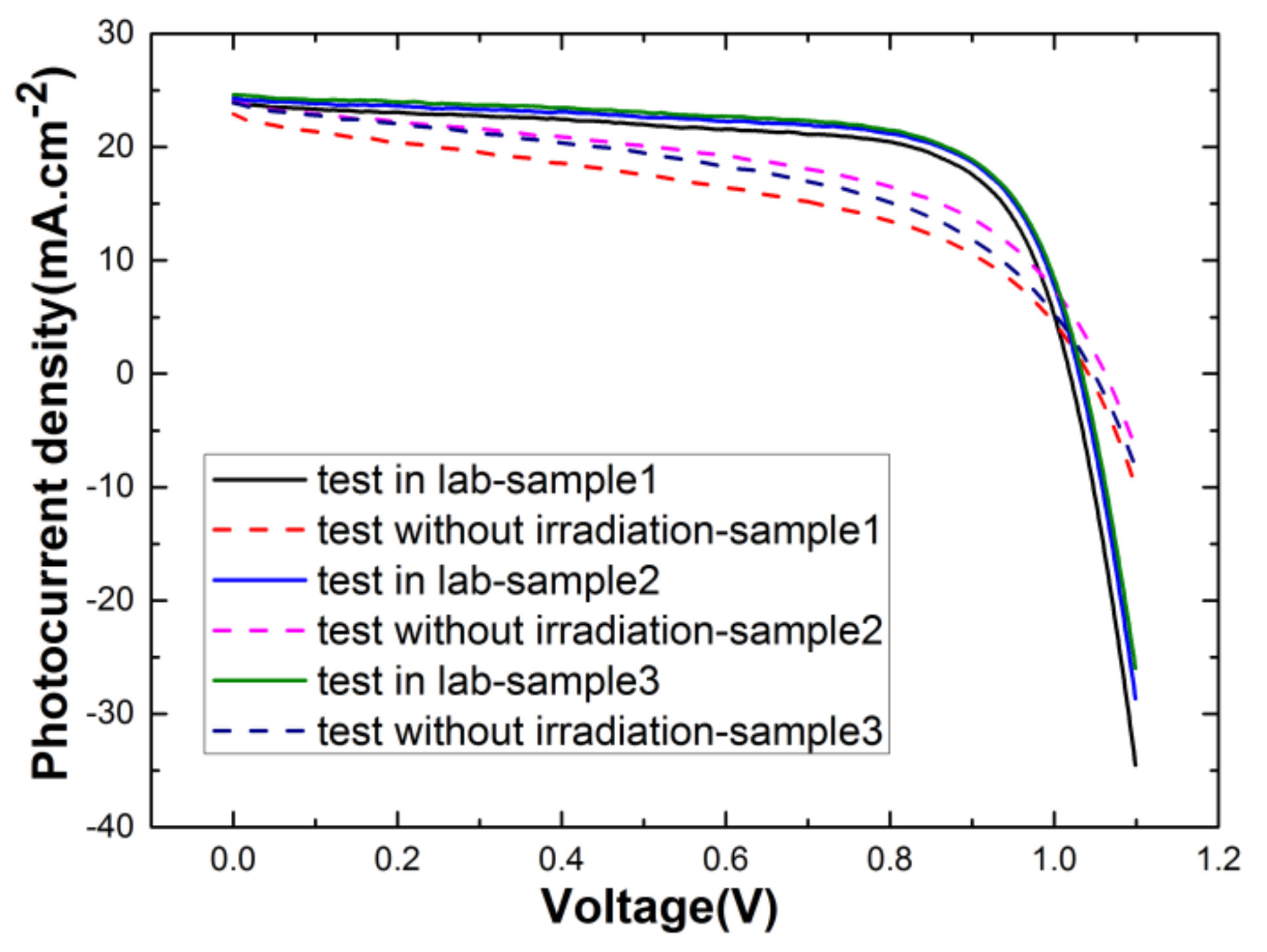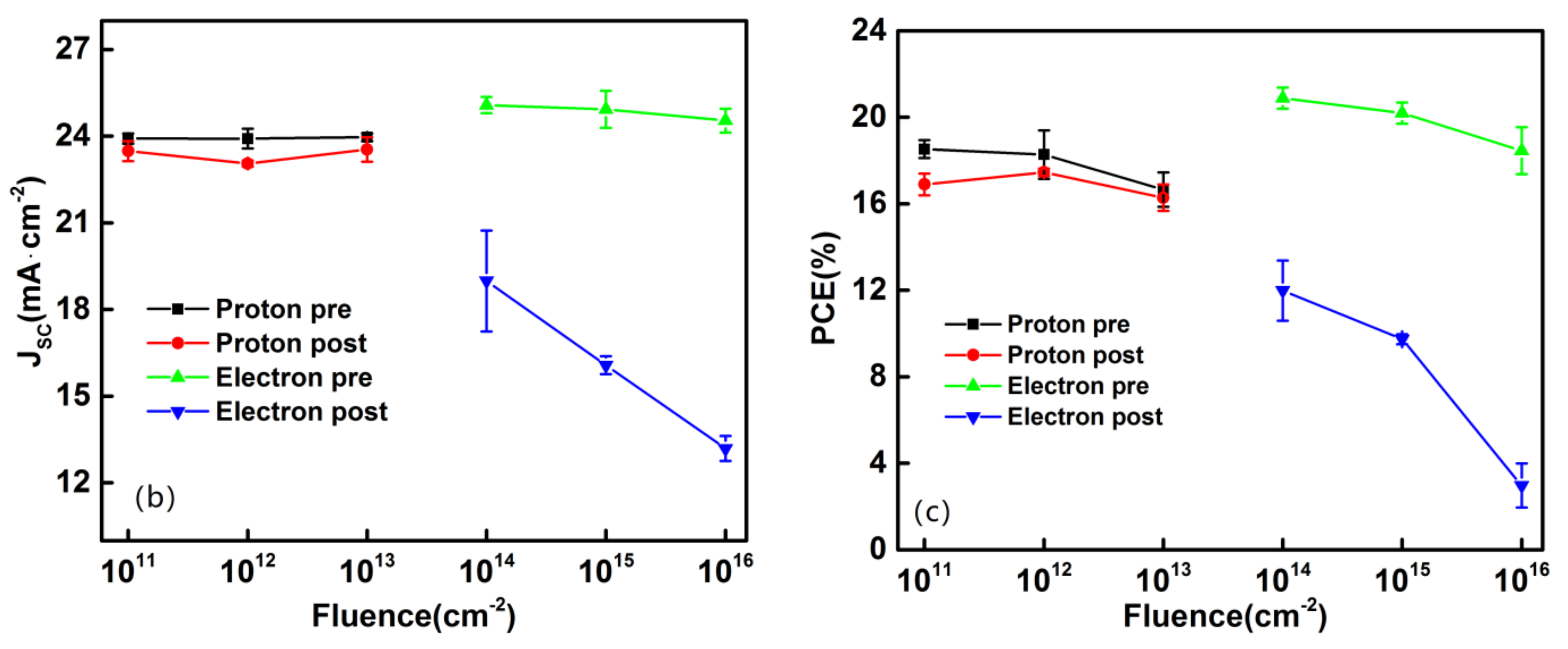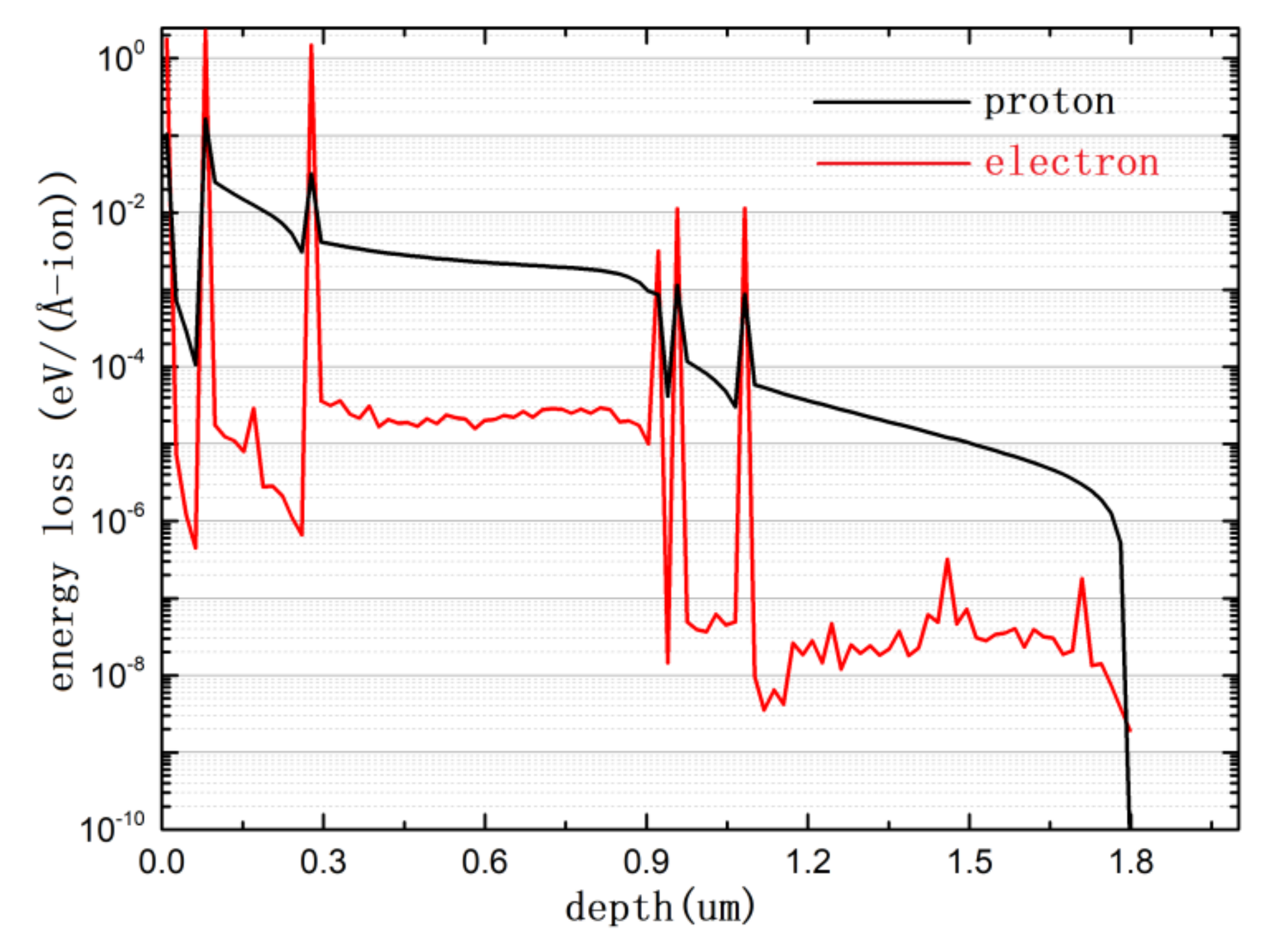Tolerance of Perovskite Solar Cells under Proton and Electron Irradiation
Abstract
:1. Introduction
2. Experiments
2.1. Materials and Experimental Details
2.2. J–V Analysis
3. Particle Transport Simulation
4. Conclusions
Author Contributions
Funding
Institutional Review Board Statement
Informed Consent Statement
Data Availability Statement
Conflicts of Interest
References
- Li, X.; Zhang, S.; Peng, W.; Lin, S. High performance solar cells based on graphene-gaas heterostructures. Nano Energ. 2014, 16, 2–5. [Google Scholar]
- Knechtli, R.C.; Loo, R.Y.; Kamath, G.S. High-efficiency gaas solar cells. IEEE Trans. Nucl. Sci. 1984, 31, 577–588. [Google Scholar] [CrossRef]
- Schermer, J.J.; Mulder, P.; Bauhuis, G.J.; Larsen, P.K.; Oomen, G.; Bongers, E. Thin-film gaas epitaxial lift-off solar cells for space applications. Prog. Photovolt. Res. Appl. 2010, 13, 587–596. [Google Scholar] [CrossRef]
- Masafumi, Y.; Nishimura, K.; Sasaki, T.; Suzuki, H.; Arafune, K.; Kojima, N.; Ohsita, Y.; Okada, Y.; Yamamoto, A.; Takamoto, T.; et al. Novel materials for high-efficiency III-V multi-junction solar cells. Solar Energy 2008, 82, 173–180. [Google Scholar]
- Garcia, I.; France, R.M.; Geisz, J.F.; Mcmahon, W.E. Metamorphic III–V solar cells: Recent progress and potential. IEEE J. Photovolt. 2016, 6, 366–373. [Google Scholar] [CrossRef] [Green Version]
- Tong, J.; Song, Z.; Kim, D.H.; Chen, X.; Chen, C.; Palmstrom, A.F.; Ndione, P.F.; Reese, M.O.; Dunfield, S.P.; Reid, O.G.; et al. Carrier lifetimes of >1 μs in Sn-Pb perovskites enable efficient all-perovskite tandem solar cells. Science 2019, 364, 475–479. [Google Scholar] [CrossRef]
- Best Research-Cell Efficiency Chart. Available online: https://www.nrel.gov/pv/assets/pdfs/best-research-cell-efficiencies.20200218.pdf (accessed on 24 January 2020).
- Yang, W.S.; Park, B.W.; Jung, E.H.; Jeon, N.J.; Kim, Y.C.; Lee, D.U. Iodide management in formamidinium-lead-halide–based perovskite layers for efficient solar cells. Science 2017, 356, 1376–1379. [Google Scholar] [CrossRef] [Green Version]
- Jeon, N.J.; Noh, J.H.; Yang, W.S.; Kim, Y.C.; Ryu, S.; Seo, J. Compositional engineering of perovskite materials for high-performance solar cells. Science 2015, 517, 476–480. [Google Scholar] [CrossRef]
- Wang, Y.; Wu, T.; Barbaud, J.; Kong, W.; Cui, D.; Chen, H.; Yang, X.; Han, L. Stabilizing heterostructures of soft perovskite semiconductors. Science 2020, 365, 687–691. [Google Scholar] [CrossRef]
- Sriabisha, R.; Hariharan, R. High efficiency perovskite solar cell. Mater. Today 2020, 33, 450–453. [Google Scholar] [CrossRef]
- Yang, J.; Bao, Q.; Liang, S.; Ding, L. Potential applications for perovskite solar cells in space. Nano Energy 2020, 76, 105019. [Google Scholar] [CrossRef]
- Paetzold, U.W.; Qiu, W.; Finger, F.; Poortmans, J.; Cheyns, D. Development of perovskite solar cells with nanophotonic front electrodes for improved light incoupling. In Proceedings of the Photovoltaic Specialist Conference, IEEE, New Orleans, LA, USA, 14–19 June 2015. [Google Scholar]
- Grancini, G.; Roldán-Carmona, C.; Zimmermann, I.; Mosconi, E.; Lee, X.; Martineau, D. One-year stable perovskite solar cells by 2d/3d interface engineering. Nat. Commun. 2017, 8, 15684. [Google Scholar] [CrossRef]
- Wang, Q.; Chen, B.; Liu, Y.; Deng, Y.; Yang, B.; Qing, D.; Huang, J.S. Scaling behavior of moisture-induced grain degradation in polycrystalline hybrid perovskite thin films. Energy Environ. Sci. 2017, 10, 516–522. [Google Scholar] [CrossRef]
- Yang, J.M.; Luo, Y.; Bao, Q.; Li, Y.Q.; Tang, J.X. Recent advances in energetics and stability of metal halide perovskites for optoelectronic applications. Adv. Mater. Interfaces 2019, 6, 1801351. [Google Scholar] [CrossRef] [Green Version]
- Lang, F.; Nickel, N.H.; Bundesmann, J.; Seidel, S.; Denker, A.; Albrecht, S. Radiation hardness and self-healing of perovskite solar cells. Adv. Mater. 2016, 28, 8726–8731. [Google Scholar] [CrossRef] [Green Version]
- Durant, B.K.; Afshari, H.; Singh, S.; Rout, B.; Sellers, I.R. Tolerance of perovskite solar cells to targeted proton irradiation and electronic ionization induced healing. ACS Energy Lett. 2021, 6, 2362–2368. [Google Scholar] [CrossRef]
- Felix, L.; Jot, M.; Frohna, K.; Khnen, E.; Stranks, S.D. Proton radiation hardness of perovskite tandem photovoltaics. Joule 2020, 4, 1054–1069. [Google Scholar]
- Shusaku, K.; Gyu, M.K.; Masashi, I.; Tsutomu, M.; Suzuki, K.; Yu, M.; Hiroyuki, T.; Kanta, O.; Tomoyuki, Y.; Kazuyuki, H. Proton irradiation tolerance of high efficiency perovskite absorbers for space applications. J. Phys. Chem. Lett. 2019, 10, 6990–6995. [Google Scholar]
- Yu, M.; Ikegami, M.; Miyasaka, T.; Ohshima, T.; Hirose, K. Evaluation of radiation tolerance of perovskite solar cell for use in space. In Proceedings of the IEEE Photovoltaic Specialist Conference, New Orleans, LA, USA, 14–19 June 2015. [Google Scholar]
- Cardinaletti, I.; Vangerven, T.; Nagels, S.; Cornelissen, R.; Schreurs, D.; Hruby, J. Organic and perovskite solar cells for space applications. Sol. Energy Mater. Sol. Cells 2018, 182, 121–127. [Google Scholar] [CrossRef] [Green Version]
- Yang, K.; Huang, K.; Li, X.; Zheng, S.; Hou, P.; Wang, J. Radiation tolerance of perovskite solar cells under gamma ray. Org. Electron 2019, 71, 79–84. [Google Scholar] [CrossRef]
- Yamaguchi, M. Radiation-resistant solar cells for space use. Sol. Energy Mater. Sol. Cells 2001, 68, 31–53. [Google Scholar] [CrossRef]
- Statler, R.L. Radiation effects on solar cells. In Radiation Effects on Optical Materials; International Society for Optics and Photonics: Bellingham, WA, USA, 1985; pp. 367–385. [Google Scholar]
- Popov, A.I.; Kotomin, E.A.; Maier, J. Basic properties of the f-type centers in halides, oxides and perovskites. Nucl. Instrum. Methods Phys. Res. Sect. B Beam Interact. Mater. At. 2010, 268, 3084–3089. [Google Scholar] [CrossRef]
- Brus, V.V.; Lang, F.; Bundesmann, J.; Seidel, S.; Nickel, N.H. Defect dynamics in proton irradiated ch3nh3pbi3 perovskite solar cells. Adv. Electron. Mater. 2017, 3, 1600438. [Google Scholar] [CrossRef] [Green Version]
- Allison, J.; Amako, K.; Apostolakis, J.E.; Araujo, H.A.; Dubois, P.A.; Asai, M.A.; Barrand, G.A.; Capra, R.A.; Chauvie, S.A.; Chytracek, R.A.; et al. Geant4 developments and applications. IEEE Trans. Nucl. Sci. 2006, 53, 270–278. [Google Scholar] [CrossRef] [Green Version]
- Agostinelli, S.; Allison, J.; Amako, K.A.; Apostolakis, J.; Araujo, H.; Arce, P.; Asai, M.; Axen, D.; Banerjee, S.; Barrand, G.J.; et al. Geant4—A simulation toolkit. Nucl. Instrum. Methods Phys. Res. Sect. A Accel. Spectrometers Detect. Assoc. Equip. 2018, 506, 250–303. [Google Scholar] [CrossRef] [Green Version]






| Parameter | Jsc/mA·cm−2 | Voc/V | FF | PCE% | |||||
|---|---|---|---|---|---|---|---|---|---|
| Structure and Fluence | Pre | Post | Pre | Post | Pre | Post | Pre | Post | |
| Electron | 1 × 1014 | 25.05 | 20.95 | 1.06 | 1.00 | 0.771 | 0.501 | 20.53 | 10.50 |
| 1 × 1015 | 25.43 | 16.32 | 1.06 | 1.06 | 0.757 | 0.556 | 20.30 | 9.62 | |
| 1 × 1016 | 24.93 | 13.49 | 1.05 | 1.00 | 0.743 | 0.301 | 19.45 | 4.05 | |
| Proton | 1 × 1011 | 23.78 | 23.09 | 1.03 | 1.04 | 0.758 | 0.725 | 18.49 | 17.39 |
| 1 × 1012 | 24.12 | 23.13 | 1.06 | 1.03 | 0.748 | 0.726 | 19.18 | 17.34 | |
| 1 × 1013 | 23.84 | 23.24 | 0.98 | 1.03 | 0.674 | 0.695 | 15.80 | 16.71 | |
Publisher’s Note: MDPI stays neutral with regard to jurisdictional claims in published maps and institutional affiliations. |
© 2022 by the authors. Licensee MDPI, Basel, Switzerland. This article is an open access article distributed under the terms and conditions of the Creative Commons Attribution (CC BY) license (https://creativecommons.org/licenses/by/4.0/).
Share and Cite
Li, P.; Dong, H.; Lan, J.; Bai, Y.; He, C.; Ma, L.; Li, Y.; Liu, J. Tolerance of Perovskite Solar Cells under Proton and Electron Irradiation. Materials 2022, 15, 1393. https://doi.org/10.3390/ma15041393
Li P, Dong H, Lan J, Bai Y, He C, Ma L, Li Y, Liu J. Tolerance of Perovskite Solar Cells under Proton and Electron Irradiation. Materials. 2022; 15(4):1393. https://doi.org/10.3390/ma15041393
Chicago/Turabian StyleLi, Pei, Hua Dong, Jinghui Lan, Yurong Bai, Chaohui He, Liya Ma, Yonghong Li, and Jiaxin Liu. 2022. "Tolerance of Perovskite Solar Cells under Proton and Electron Irradiation" Materials 15, no. 4: 1393. https://doi.org/10.3390/ma15041393
APA StyleLi, P., Dong, H., Lan, J., Bai, Y., He, C., Ma, L., Li, Y., & Liu, J. (2022). Tolerance of Perovskite Solar Cells under Proton and Electron Irradiation. Materials, 15(4), 1393. https://doi.org/10.3390/ma15041393






